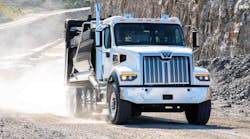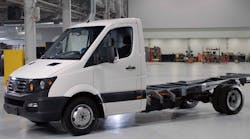With many speculating what the incoming Trump Administration will mean for trucking, "those are really more 2018 considerations," noted Kenny Vieth, president of ACT Research, in a Stifel Capital Markets call Friday. In terms of next year, though, the group expects just over 200,000 Class 8 trucks will be built for the North American market.
"We've just got too many trucks and not enough freight," Vieth surmised. This year should close out at about 228,000 Class 8 trucks built before a continued downward trajectory into 2017. But several factors are likely to help the market pick back up starting in 2018, when ACT expects that 243,000 Class 8 trucks will be built.
And things could be on the road to much better after that, should a number of elements fall into place. "If everything goes according to the script that I have written, the conditions should be in place for a very nice Class 8 market in 2019 and 2020," he said.
As noted, Vieth pointed out that possible beneficial economic moves from the Trump Administration like pushing for tax cuts or infrastructure investments would come no sooner than 2017, and the fruits of any changes wouldn't be seen until 2018 and going forward.
"We've got at least two years to find out what total Republican dominance does to policy, just as we did in 2009 and 2010 when the Democrats had the same opportunity," Vieth explained, noting Republican control of the presidency and Congress. That control "should mean free policy rein, and I do recall the Barack Obama quote from 2009 that 'elections have consequences,'" he added.
With the Trump Administration, some things to watch will be stances on trade, foreign policy and immigration, Vieth said, "and then there is the 3 a.m. tweet thing, which I think makes us all a little bit nervous."
All jokes aside, the North American Class 8 market was considerably weaker during the first 10 months of 2016 vs. the same time the prior year. The United States, which accounts for 81% of the market, saw a year-over-year Class 8 decline in that time of 47%. Canada, which is 9% of the market, saw a 26% decline in Class 8.
But one bright spot for Class 8 was Mexico, which represents about 8% of the North American market. The country has seen growth of 25% for the first 10 months of the year compared with the same 2015 period. Ultimately, it's still a 25,000-unit market, so what happens there only ripples so far.
Still, "if there's a question regarding the future Trump Administration's policies, Mexico is a key consideration," Vieth noted.
The thinking generally is that the new administration will ease up on regulations, he said, which should be a boon for businesses: "Whether it's labor, environmental or safety, those had been increasing headwinds for business and are likely to be mitigated."
Even if the new administration ultimately lightens the regulatory burden, Vieth said not to expect GHG Phase II requirements to evaporate. "I think the paybacks are so good on aerodynamics and parasitic drag that even if the Greenhouse Gas Phase II rules get rolled back, the vast majority of that mandate is going to happen because of the bang for the buck for fuel economy relative to cost," he contended.
"I think the vast majority of the GHG Phase II proposal is almost 'baked in the cake,' regardless of what the Trump Administration does."
Notably, ACT kept a more favorable 2018 forecast for Class 8 now that Donald Trump was elected president. Vieth said the group considered the difficulty a theoretical President Hillary Clinton would face with a Republican-led House of Representatives and Senate, particularly with funding issues.
"Before the election, we were thinking of something like 225,000-230,000 [total Class 8 North American market units built for 2018] might've been a better place" than ACT's prediction of 243,000, Vieth contended. "That was kind of from the realization of having Hillary Clinton as president with the continuation of a Republican-led House of Representatives, which I don't think was ever in doubt.
"Then all of a sudden, if we try to push through a $500 billion infrastructure package, the House would say, 'Okay, but you have to cut $500 billion worth of spending.' So the aggregate level of spending was not going to change all that much."
President Trump should face smoother going in terms of working with Congress, but what will come of Republican legislative efforts is yet to be seen. If the rosier 2018 predictions are to come about, there will be indicators by about the third quarter of 2017, Vieth said.
"As we look back through history, I want to say that every up-cycle that we've seen in the marketplace has started in the fourth quarter," he noted. "So if conditions aren't sufficiently good by the third quarter of 2017, you don't get bigger orders in the fourth quarter of 2017, which doesn't start production in time.
"So that's that 15,000-20,000-unit delta that we were contemplating."
For Class 8, the present reality comes from a cyclical downturn that came on fairly dramatically. "From the end of 2014 to the end of 2015, we went from the top of a cycle to a rapidly deteriorating market heading into 2016, and it continued to deteriorate through most of the first half of 2016," Vieth said.
That deterioration has stopped or at least slowed, he added, "but in short, in the current market, we've just got too many trucks and not enough freight."
How many too many trucks is that, exactly? According to Vieth, ACT's fleet utilization model suggested there was about a 5% capacity shortfall at the end of 2014; today, the model shows the market is about 7% overcapacity. "From our model's perspective, that's about 105,000 more tractors than are currently needed in the marketplace," he said.
Precipitating the market declines for freight were dips in machinery and capital goods, Vieth pointed out, where "you've got six-to-eight touches by a truck on a relative dollar basis." "Freight started going wrong when the commodity bubble popped in the second half of 2014," he contended. "All of a sudden, all the commodity extractors — whether it was the oil guys, coal guys, steel guys, aluminum guys or farmers — they're all like, 'We're not making any money; we don't want any [new] machines.'"
Keeping in mind ACT's approximately 100,000 excess truck estimate, productivity gains are also part of the Class 8 story. In 2013, truck tonnage in North America began a continuous climb while truckloads stayed relatively the same, according to figures Vieth cited from the American Trucking Assns.
"Coming out of the recession, we've seen a lot of truck tonnage growth without a lot of loads growth," he told listeners. "Where is it? Increased density? Increased utilization? A little bit of modal share? A little bit of online retail shift?
"Were we operating under the same conditions as we were during the last cycle, we would actually need about 10% more tractors — about 150,000 more tractors — than are currently on the road today to haul the same amount of freight," he continued. "So you can see the problem in a nutshell: especially in a slow-growth economy, high productivity growth leads to weak freight outcomes."
Meanwhile, the U.S. has seen far less decline in the Class 8 vocational sector. "If you look at the U.S. numbers, we're not so bad in the vocational market," Vieth said. "One of the reasons we don't have a 'hair on fire' bad forecast for 2017 is that the quarter of the market that is the vocational piece is holding up reasonably well."
Class 8 inventories are still swollen, but truck OEMs have adjusted production rates down accordingly. "We've worked a lot of inventory off, but there's still a lot of inventory to work off," Vieth said.
In terms of sales-to-production balance, Vieth said trailers held up strong for about a year after the Class 8 tractor market began its decline, but they're now headed for their own equilibrium adjustment. "We saw trailer backlogs drop below 100,000 units in October, which was the first drop below 100,000 since early 2014," he noted.
"We still haven't adjusted production relative to the size of the backlog," Vieth argued. "So we think there's certainly some production cuts coming up there."
Some signs on the economic horizon, he noted, are looking up. In terms of strengths of lead indicators like commodity trends, stock market prices and consumer confidence, "over the last couple of months, it's generally been a better tempo on economic reports," Vieth said.
Look for "generally slower growth" in the U.S. economy, with a pick-up likelier by around the mid-term elections. The economic recovery is at a tepid 2.1% growth in GDP and 2.1% growth in manufacturing, but there are encouraging signs regarding the latter.
"We're seeing some nice improvement on a worldwide basis in manufacturing," Vieth said. "That's very good to see." He noted that Germany, the United Kingdom and India are seeing above trend growth in manufacturing, while China has moved to trend-type growth.
"In our argument of what's wrong with freight in the United States, it really gets back to commodity prices," Vieth emphasized. "How you fix commodity prices is you fix aggregate demand for commodities globally.
"In the last few months, things are getting better globally," he said.








